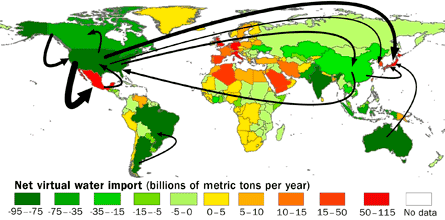Water’s worldwide travels
Scientists track the movement of ‘virtual water,’ used in the production of goods and exchanged among nations

Water runs downhill from mountaintops to streams to rivers to oceans. But downhill isn’t the only way that water moves. A new study measures how water travels from country to country. This water moves to make foods and products. This flow isn’t the type we usually think about. But scientists have now looked at the water used to grow and make the products that get shipped from nation to nation as imports or exports. They call this a flow of “virtual water.”
We typically think about water as the liquid that flows from a faucet. However, nearly all — 92 percent — that is used by people goes into growing crops. That’s according to water researcher Arjen Hoekstra. He works at the University of Twente in the Netherlands. His team recently studied the hidden travels of virtual water used in products made from things like crops and meats. These products are shipped around the world.
For example, consider a sugary soft drink. Hoekstra and his team estimated that making one half-liter of the beverage requires between 170 and 310 liters of water. Only a tiny amount of that — about 1 percent — is the water actually in the soda. The vast majority — about 95 percent — is water used to grow and process the ingredients. Another 4 percent goes into the packaging and labeling, the scientists say. (The exact amount of water required depends on the sweetener being used.) In Hoekstra’s calculation, when one country produces a half-liter of soda and sells it abroad, it exports as much virtual water as would fill a large refrigerator.
Dry countries like Israel and Kuwait, both in the Middle East, get the majority of their virtual water from other countries, through imported products, Hoekstra’s new report finds. More surprisingly, some wetter countries, like the Netherlands and the United Kingdom, also get the majority of their virtual water from other places. That means that most of the water used to grow or produce the products and food consumed in those countries came from elsewhere.
In the United States, most virtual water is American; only about 20 percent of the virtual water comes from other countries. In China, only about 10 percent of its water used in making products comes from foreign countries.
By tracing the water trade, Hoekstra and his team turned up other surprising relationships. For instance, often an arid region sends virtual water to a wetter region. Dry areas in northern China, for example, send virtual water to the southern part of that country, which is wetter.
“There are exporting regions that do have a lot of water stress,” he told Science News.
POWER WORDS (adapted from the New Oxford American Dictionary)
arid Having little or no rain; too dry or barren to support vegetation.
agriculture The science or practice of farming, including cultivation of the soil for the growing of crops and the rearing of animals to provide food, wool and other products







